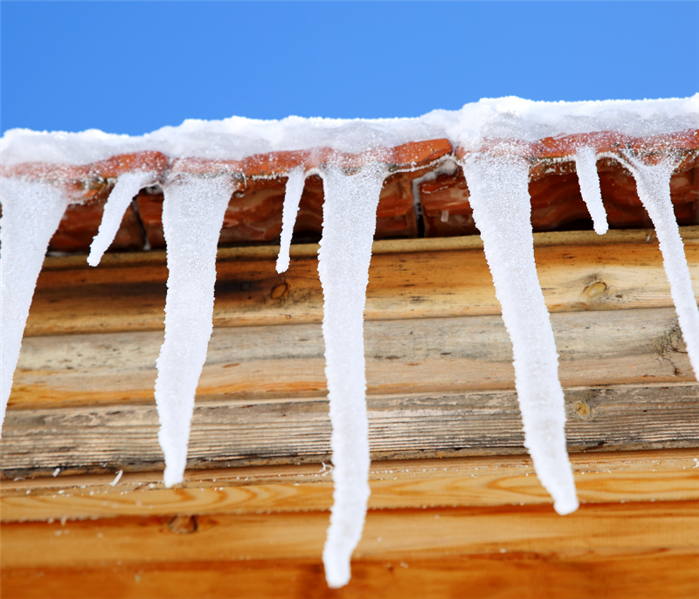Ice Dam Damage in New Jersey
2/9/2021 (Permalink)
 Ice dams in New Jersey can cause water damage, mold growth, and structural issues inside of your home.
Ice dams in New Jersey can cause water damage, mold growth, and structural issues inside of your home.
When ice dams form on your roof in New Jersey, your home can be in for trouble. While most know that excessive snow and ice can cause roof damage, did you know about the interior damages they can cause too? Ice dam damage inside your home can cause serious water damage to floors, ceilings, walls and even cause a mold infestation.
Here, we will go over the different types of damages from snow and ice leaking into your New Jersey home.
How Causes Ice Dams To Form?
When there's warm air in your attic, it can warm your roof and cause the snow on the eaves to melt and flow down to the edges. When snow water reaches the edge of the roof and meets more snow, it can refreeze. This is because the edges of your roof hang past the structure of your home, making them cooler than the rest of the roof.
Over time, this process forms a wall of ice and snow which prevents melting snow from running off the roof. This causes a pool of water to become trapped underneath the ice dam. The trapped water backups up and pools under flashing and shingles, which causes the roof to leak and results in water damage inside of your home.
Do They Always Cause Damage?
Ice dams in New Jersey don't always have to cause damage to your home. If the dam is removed or if warm weather comes in time to melt the snow and ice, the problem can resolve itself. Unfortunately, this isn't always the case. Many times ice dams worsen until action must be taken by the homeowner.
Problems Caused By Ice Dam Damages
There are many different types of damages that can be caused from excess snow and ice on your roof in New Jersey. The top problems include water leaks, structural damage, and mold growth.
Ice Dam Leaking into House
Snow and ice can easily leak into your home once they've penetrated the roof deck. It's not likely for these to immediately leak into your home in New Jersey, so that's why it's important to remove them before they begin to cause damages. Once snow and ice leaks into your home, you're at a high risk of sustaining water damage and mold growth.
Ice Dam Leak in Wall
If you notice water damage to a wall but the source isn't a leaking, frozen, or burst pipe, the next culprit is likely an ice dam. Since snow and ice builds up on the edge of the roof, it can damage the soffit and fascia on the exterior of your home. These roofing components are designed to keep pests and water out of your home - so when they're damaged, it can result in snow leaks inside your home.
Ceiling Leak From Ice Dam
When ice dams cause roof leaks, they're likely to cause ceiling leaks as well. This is because snow water leaks from the roof, through attic insulation, onto the attic floor, and then through the ceiling and into the living space below. You may notice water stains, sagging ceilings, or water in light fixtures when dealing with ceiling leaks from an ice dam.
Mold Growth
Once snow and ice leaks into your home, mold growth is highly possible. Mold thrives on moisture and can begin to grow and spread in as little as 48 hours after water damage or flooding.
Roof Damages
Other than the leaks that they cause, ice dams can also cause structural damages to your roof, causing the gutters to sag or damaging soffit and fascia boards. This opens your roof up to further damages in the future after heavy rains or high winds in the summer.
What To Do When Ice Dam Water Leaks Into The House
You should immediately take these steps to handle the water seeping into your home from ice dams.
1. Call A Water Damage Restoration Company
Since the water damage from snow and ice leaking into your home in New Jersey can be so widespread, you should call a local damage restoration company to handle the mess. Your home may have wet walls, floors, sagging ceilings, wet insulation, or even mold growth from the ice dam.
2. Remove the Ice Dam
To prevent further ice dam damage inside your home in New Jersey, removing the excess snow and ice on your roof is one of the first steps you should take. There are many methods for DIY removal, but these include climbing onto your snowy, icy roof. The safest way to remove ice dams for you and your home is to call a local company that provides the service.
3. Contain Water Damage
If water is leaking from the ceiling or roof, set up buckets and towels to catch water. Until help arrives, you should set up fans in the most affected areas. You should keep checking the roof and attic for any signs of additional leaks.
Is Ice Dam Damage Covered by Insurance?
The good news is that ice dams are covered by insurance. But, insurance won’t cover the cost of removing the ice dam. The remaining water damage restoration services needed will be covered.

 24/7 Emergency Service
24/7 Emergency Service